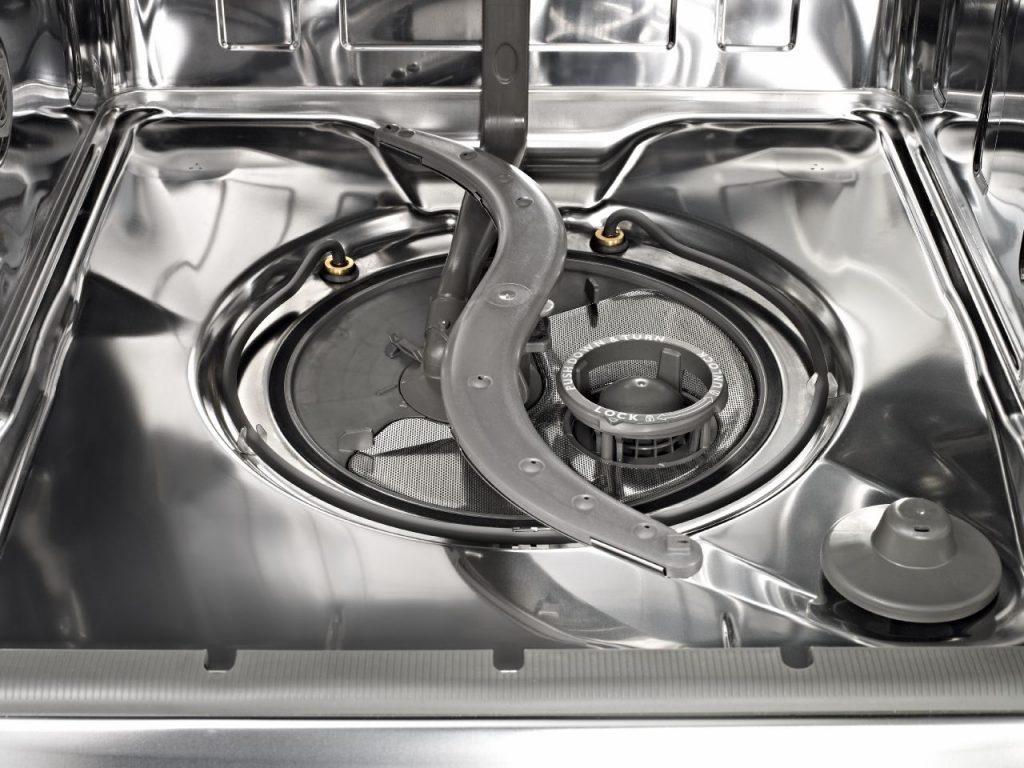When Does the Heating Element Turn on In a Dishwasher?
When you select a dishwasher cycle to start the cleaning process, the dishwasher starts by filling the bottom with water.
The dishwasher’s heating element comes on once the water level has risen past an inch or two.
The water level is managed by a float switch. It detects how much liquid is in the bottom basin and activates when it reaches its threshold.
When the heating element is working to dry the dishes, it will come on when the heated drying cycle is on.
Read: Is It Necessary to Use Rinse Aid in Dishwasher?
What Do Heating Elements Do in The Dishwasher?
A dishwasher’s heating element provides heat to the water inside of it, which helps sanitize your dishes.
Heating elements in a dishwasher are responsible for making sure that the dishes have been properly cleaned and sanitized before being removed from the machine.
The heated water is sprayed over your dishes, effectively removing food particles and bacteria without you having to scrub them off with a sponge or other cleaning utensil.
A dishwasher’s heating element works by converting electrical energy into thermal energy which then warms up the water inside the washer.
Heating elements are found behind or under the lower spray arm. The heat is transferred to water entering at this point and heated by a coil beneath it.

A dishwasher element is also responsible for drying dishes in some dishwasher brands.
This process dries dishes better than using heat.
This is because some of the moisture is evaporated when it comes into contact with the hot coil and spray arm.
There are two types of heating elements:
an electric resistance type (which heats up when electricity runs through it) and;
an infrared type (which heats up when heated by microwaves).
How Do I Know If My Dishwasher Heating Element Is Working?
You’ll know whether your dishwasher element is working using the temperature gauge, touching the dishwasher surface, or using a multimeter.
Temperature Gauge
The first thing you can do is check the temperature gauge on your washer: when it reaches its set point, then the heating mechanism should be at work.
You can also observe whether dishes come out clean and shiny or not; this may require some experimentation with the wash cycle you use.

Dishwasher Surface
You can feel the dishwasher’s surface to see if it is hot.
For example, its door panel and exterior walls might get heated up quickly when on a high-temperature setting.
The heating element should be warm to touch if it is working correctly, but don’t touch any metal parts as they may still be hot and burn.
If your dishwasher has an inbuilt sensor, it will shut off power automatically once the water temperature reaches boiling point.
Then, the heating element will turn off when that happens.
Use a Multimeter
Another way to test a dishwasher heating element is to use a multimeter to determine the resistance.
Get a step-to-step guide on how to use the multimeter here.
You can also check if your dishwasher is draining properly.
It should be possible to see water coming out from beneath the appliance’s gasket, and this may indicate a problem with its internal pump or valve system.
This would not necessarily mean that there was an issue with the heating element, but it is still worth checking out.
Here are signs that you need to replace your dishwasher.
How Long Does It Take for A Dishwasher to Heat Up?
The dishwasher’s heating element heats water for washing and drying dishes by using electricity or gas.
It can take about 30 minutes for a heated appliance to reach optimum temperature after its power has been switched on.
Can You Run a Dishwasher Without a Heating Element?
If your dishwasher uses the heating element for drying as opposed to heating water, the dishwasher can function without it.
There are alternatives for drying your dishes after a wash cycle such as air drying.
Running your dishwasher without the heating element and without taking the necessary precautions will prevent dishes from drying properly. This can lead to mold and bacteria growth.
Heating elements are an integral part of most dishwashers.
If your heating element has stopped working, it could be as a result of there being too much grime and limescale in the water.
It is important to identify the issue and replace the element immediately.
How Often Should You Replace Dishwasher Heating Elements?
The lifespan of a heating element varies depending on how often one uses their dishwasher, but it typically falls between 12 to 18 months.
As they age, they will gradually lose effectiveness in drying dishes.
You may also notice that the dishes don’t come out as clean and the temperature of the dishes is cold.
How To Replace Heating Element in Dishwasher
First, turn off the power to your dishwasher and unplug it from its electrical outlet.
Next, remove all of the dishes and soak them in soapy water for a few minutes or until they are fully clean before drying them completely with a towel.
Wipe out the inside of your dishwasher, then wrap up any cords and remove the mats from both lower areas.
To access the heating element in a dishwasher, you will need to unscrew and open either lid or door.
This gives you room to slide your hand at least halfway under it on one side.
Once you have located the heating element, you will need to detach it from the other components.
You do this by unscrewing the screws that are holding it in place with a screwdriver or wrench before removing and replacing it with another one.
Once you have removed and replaced your dishwasher’s heating element assembly, be sure to turn on the power to your dishwasher.
If the heating element is still working properly, you will need to wait for your dishwasher to heat up before running a cycle on it.
It takes about 45 minutes from when you start a load until it reaches its full temperature and should be safe to use again.

